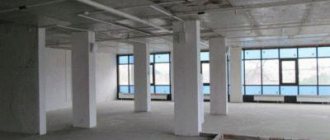Definition and characteristics of a non-residential property
The very name “non-residential” speaks for itself – i.e. such a premises cannot be used for living; accordingly, it can be used for production or public purposes.
There is no clear legal term that gives an answer to the question of what the purpose of non-residential premises is in the current legislation of Russia. However, in accordance with the norms of the Housing and Civil Code, it has a number of distinctive features that allow it to be distinguished from other objects:
- Belongs to real estate, i.e. is an integral part of the building, which indicates its significant difference from the structure.
- It is isolated and has certain boundaries.
- It has a close relationship with the land plot and is located at a specific address.
Purposes of its use
The purposes of using non-residential premises must correspond to the type of activity carried out in it, and can be as follows:
- Communal and household.
- Medical.
- Educational.
- Trading.
- Production.
- Warehouse.
- Office.
- Sports.
- Intended for public catering.
- Free appointment, etc.
EGRN includes a list of information presented in text and graphic form, and consists of: real estate cadastre, register of rights to real estate, register files, register of boundaries, cadastral maps and books of documents (Article 7 of the Federal Law No. 218 of July 13, 2015 .).It is worth noting that the Register stores not only current data, but also previously entered information about real estate objects.
According to functionality, there is a division into:
- Basic.
- Attendants.
- Technical.
- Communication.
- Auxiliary.
Thus, non-residential premises can be used for a variety of purposes, in addition to living in them.
Purpose of non-residential premises - what is it?
The concept in question does not have a legislative definition, but is only designated in accordance with the order of the Ministry of Economic Development of the Russian Federation No. 943 dated December 16, 2015, which approved the procedure for maintaining the Unified State Register of Real Estate.
The document stipulates a clear division of premises according to their purpose into residential and non-residential. The former can be used exclusively for residence, the latter are divided according to their intended purpose in accordance with the type of permitted use in the Unified State Register of Real Estate.
Attention! Because Non-residential premises have different purposes of use, and therefore the requirements for them are different. This applies to sanitary, fire and other standards. The requirements presented significantly narrow the boundaries of the use of the premises, which is reflected in its purpose.
Improper use - liability
Using non-residential premises for other purposes is fraught with administrative liability , and therefore, both legally and in fact, one must adhere to all legal requirements and norms.
In addition, Art. 15 of the Housing Code of the Russian Federation contains a number of requirements that a residential premises must meet, and, therefore, if they are violated, living in it is prohibited, it is automatically recognized as non-residential.
There is currently no direct liability for living in a building that does not meet the requirements of the law. But there are penalties regarding non-compliance with SES standards : noise level, layout, occupied space, lighting, etc.
In monetary terms, ordinary citizens face a fine of 500-1000 rubles, officials and individual entrepreneurs will have to pay 1000-2000 rubles, and legal entities - 10,000-20,000 rubles. Entrepreneurs also face suspension of activities for up to 90 days, and legal entities. persons for a period of up to three months (Article 6.4 of the Code of Administrative Offenses of the Russian Federation).
The essence of imposing fines is not punishment as such, but the protection of the life and health of the citizens themselves, because staying in a facility that does not meet the requirements is not at all safe .
What it is?
A non-residential building is a building that is not intended for human habitation. Although the legislation of the Russian Federation does not contain the concept of this object, it establishes the main features by which it can be identified.
So, according to Art. 15 of the RF Housing Code for non-residential premises is characterized by the following:
- It must relate to real estate.
- It must be insulated (the means of insulation in this case are the integral parts of each room: ceiling, walls and floor; an equipped entrance/exit is required).
- Must be suitable for habitation.
What is this “free-use premises”? This concept is used in commercial slang. You will not find it in any law or in any official document. It appears very often in advertisements. It refers to small buildings or parts thereof that are not intended for habitation. Their goal is to equip a cafe, or a store, or an office, or a warehouse, and so on.
Important! The main thing is that the registration documents include a note that the premises belong to the non-residential property.
With this status, the advertiser wants to convey to potential clients that the purpose of the premises is not defined, and therefore the latter have greater freedom in its use. There are plenty of options for using a free space. However, they should not be considered universal.
Once it reaches a specific goal, a lot of nuances will emerge that require redevelopment, additional approvals, and re-issuance of documents.
Definition of concepts among such objects
Free status
A non-residential property can be given the status of a free-use premises, which allows it to be used in various fields of activity. Such an object can be repurposed at any convenient time if necessary, which significantly saves the owner’s time and money. Most often, vacant premises are intended for rent, and therefore a change in purpose occurs much more often than usual. They are used for offices, hairdressers, shops.
Free-use premises, contrary to their status, cannot be used for all areas of activity . In some situations, additional permits will be required.
Reference. The cost of free-use objects is significantly higher than similar options indicating a specific purpose.
Residential status
A change in the purpose of using a room in a building is not a reason for reconstructing the building itself. This is where the concept of non-residential premises with a residential purpose arose. Consequently, the building may be non-residential, but the premises located in it are suitable for habitation.
Thus, the main task of the owner is to go through the procedure for making adjustments in a timely manner, which we will discuss further.
How to change the purpose of residential premises to non-residential
The arrangement of retail outlets and other small business facilities on the first floors of apartment buildings is widespread throughout Russia. In almost all such cases, before opening a retail outlet, it is necessary to convert residential premises into non-residential premises. The branch of the Federal State Budgetary Institution "FKP Rosreestr" in the Altai Republic informs residents of the region how to change the designation of residential premises to non-residential.
Firstly, the transfer of residential premises to non-residential premises is not allowed if access to the transferred premises is impossible without the use of premises providing access to residential premises (for example, the entrance of a house), or there is no technical ability to equip such access, and also if the transferred premises is part of the residential premises or is used by the owner of this premises or another citizen as a place of permanent residence, and also if the ownership of the transferred premises is burdened with the rights of any persons.
Secondly, the premises being converted from residential to non-residential, located in an apartment building, must be on the first floor or higher, while the premises located directly below such an apartment should not be residential.
Thirdly, it is not allowed to transfer residential premises to non-residential premises in a rented house for social use, as well as for the purpose of carrying out religious activities
If the premises meet all the requirements for transfer from non-residential to residential, your next step will be to contact the local government authority or the MFC My Documents office with the following documents: an application for transfer of the premises; documents of title for the premises being transferred (originals or notarized copies); a plan of the premises being transferred with its technical description (if the premises being transferred is residential, the technical passport of such premises); floor plan of the house in which the room being transferred is located; a project for the reconstruction and (or) redevelopment of the transferred premises prepared and executed in the prescribed manner (if the reconstruction and (or) redevelopment is necessary for the use of such premises as non-residential premises).
If the transfer of premises is agreed upon, you will be given a decision to transfer residential premises to non-residential premises, and if not agreed upon, then a decision to refuse to provide a public service.
If it is necessary to carry out work on redevelopment of the premises or reconstruction, then you can now begin such work, upon completion of which an acceptance committee report is drawn up, which confirms the completion of the transfer of residential premises to non-residential premises and is the basis for using the premises as non-residential.
After this, you can submit an application to the branch of the Federal State Budgetary Institution "FKP Rosreestr" in the Altai Republic or to the offices of the MFC "My Documents", as well as to the official website of Rosreestr (www.rosreestr.ru) to take into account changes made in the state real estate cadastre, where you should submit a technical plan prepared based on the results of the changes made, and if redevelopment or reconstruction was carried out, then it will also be necessary to submit a redevelopment project and an acceptance committee report on the completion of the relevant work.
The final stage will be obtaining an extract from the Unified State Register of Rights to Real Estate and Transactions with It, certifying the state registration of rights. To do this, owners or an authorized representative need to submit an application to the branch of the Federal State Budgetary Institution "FKP Rosreestr" in the Altai Republic or to the offices of the MFC "My Documents", as well as to the official website of Rosreestr (www.rosreestr.ru).
The procedure for changing the target functional purpose
, as well as the tenant with prior agreement with him, have the right to change the intended purpose To learn how to change the purpose of non-residential premises, it is important to study the step-by-step algorithm of actions. Changes can be made in two ways:
- By transferring to residential premises (in accordance with Chapter 3 of the Housing Code of the Russian Federation).
- By changing the type of activity for which it was intended.
This procedure is quite complex and consists of a number of steps:
- Preparation of the project and its approval by all supervisory services (SES, Vodokanal, Ministry of Emergency Situations, etc.).
- Collecting documents and submitting them to local authorities.
- Carrying out construction and other work in accordance with the approved project and putting the building into operation.
- Registration of a technical passport at the BTI.
- Obtaining a new cadastral passport and registering a certificate of ownership in the unified USRN database.
Which authorities should I contact?
To determine which authorities will be required to obtain permits, you need to find out what the object was used for.
Any type of activity requires compliance with fire and sanitary-epidemiological standards. Therefore, the applicant needs to coordinate his intentions with the district fire inspection department and Rospotrebnadzor.
The owner will need to contact the BTI to obtain plans of the premises located above and below the object in question. The result will be the receipt of an agreement signed by representatives of all authorities, the main one of which will be the local administration.
Project preparation
Before drawing up a project, it is necessary to consider a number of important points:
- Condition of load-bearing walls and floors.
- Correct wiring.
- Condition of the water supply system.
- Possibility of redevelopment in the selected building.
After the preliminary examination, you can begin to draw up a project, which may include additional parameters:
- Ventilation system.
- Facade decoration.
- Water supply and heating system.
- Other design solutions.
The results of the design work should be agreed upon with the following services in the specified order:
- Housing inspection.
- Fire supervision.
- SES.
- Expert Bureau.
- Department of Architecture (if it is planned to change the facade of the building).
List of documents
To repurpose non-residential premises, the following documents will be required:
- Application from the owner of the premises.
- Documents confirming the legality of ownership.
- Explication.
- Technical plan.
- Redevelopment project.
- Certificates from the BTI about inventory value and technical condition.
- Certificate of timely payment of utilities.
Getting permission
Self-government bodies of a constituent entity of the Russian Federation study the submitted package of papers within 6 days and make a decision to change the purposes of its use. If the result of the review is positive, the owner receives a permit with an unlimited validity period. If there are violations, they are given a 10-day period to eliminate them and the opportunity to re-apply.
Cost of the procedure
The costs will consist of several parts:
- Project preparation.
- Payment for housing inspection services.
- Payment for redevelopment.
- State duties.
The amount of costs will depend on the region . For example, the cost of the procedure in Moscow and the region will be expressed in the following amounts:
- For the preparation of a technical report you will have to pay about 25 thousand rubles.
- Drawing up a building project will cost approximately 130 thousand rubles.
- BTI services will cost 60 thousand rubles.
- Architectural work – 30 thousand rubles.
- The final adjustments will be 45 thousand rubles.
In remote regions, the price may differ significantly, and the total cost will be only 60-70 thousand rubles.
Deadlines
Typically, the preparation of a technical report takes 1-2 business days. However, the concept of deadlines in this procedure is a relative concept:
- Drawing up an architectural plan may take up to 14 days.
- Preparation of certificates from the BTI will take 10-30 days.
- It will take about 30 days to receive a cadastral passport with the adjustments made.
Thus, if the project is complex, the duration of work will be about 2 months.
The final stage
The final stage is obtaining a cadastral passport with an updated layout and registering a new certificate of ownership. The cadastral plan of the premises can be changed on a technical basis. At the same time, the time frame for making amendments varies from 3 to 18 days and depends on the complexity of the work being carried out.
So, the purpose of non-residential premises plays a decisive role in the possibility of its operation. The owner may be held liable for illegal use, and therefore his main task is to make timely adjustments if a change of activity is planned. This procedure is quite labor-intensive and requires not only time, but also financial costs. However, by following the scheme given in the article, you can avoid problems in the future.
Non-residential premises in the residential fund
Increasingly, cases have begun to arise when non-residential premises are transferred to residential premises, since studio apartments, gallery apartments and the like are now gaining the most popularity. But changing the purpose of a building is not so easy.
After all, a whole list of mandatory conditions is described for ordinary apartments, such as:
- Technical characteristics and supporting structures must be in full working order, comply with certain standards and be recognized as suitable by sanitary and technical authorities;
- The residential building itself must be located in a regular residential area with developed infrastructure;
- In non-residential premises there must be opportunities for basic household communications;
- The sizes of windows, doors and other openings must comply with standards and not threaten the safety of citizens.
Provided that your non-residential building or premises meets the above requirements, you can begin collecting documents and beginning the process of changing the status of the object through interdepartmental commissions.






